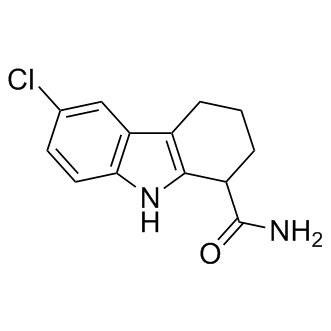| Cas No.: | 49843-98-3 |
| Chemical Name: | 6-Chloro-2,3,4,9-tetrahydro-1H-carbazole-1-carboxamide |
| Synonyms: | (±)-EX-527; (±)-EX 527; (±)-EX527; Selisistat racemate; Selisistat racemic |
| SMILES: | C1CC(C2=C(C1)C3=C(N2)C=CC(=C3)Cl)C(=O)N |
| Formula: | C13H13ClN2O |
| M.Wt: | 248.71 |
| Purity: | >98% |
| Sotrage: | 2 years -20°C Powder, 2 weeks 4°C in DMSO, 6 months -80°C in DMSO |
| Description: | Selisistat (EX-527) is a potent and selective SIRT1 inhibitor with IC50 of 98 nM. |
| Target: | SIRT1:98 nM (IC50) SIRT2:19.6 μM (IC50) SIRT3:48.7 μM (IC50) |
| In Vivo: | Selisistat (EX-527) abolishes Resveratrol (RSV)-induced attenuation of microvascular inflammation in ob/ob septic mice. Finally, ob/ob mice in Sepsis+RSV group has significantly increased 7-day survival vs. Sepsis+Vehicle group[3]. |
| In Vitro: | Selisistat (EX-527) is an inhibitor of SIRT1 enzymatic activity (IC50, 98 nM), identified in a high-throughput screen using bacterially expressed human SIRT1. Selisistat (EX-527) inhibits SIRT1 in a concentration-dependent manner with an IC50 of 38 nM, in agreement with the activity on bacterially expressed SIRT1. Selisistat (EX-527) has much lower potency against SIRT2 (IC50, 19.6 μM) or SIRT3 (IC50, 48.7 μM) but does not inhibit class I/II HDAC activity at concentrations up to 100 μM[1]. Selisistat (EX-527) exerts an inhibitory effect on SIRT1 activity without affecting SIRT1 expression on both mRNA and protein levels[2]. |
| Cell Assay: | The immortal mouse macrophage cell line RAW264.7 are used. Cells are seeded in 96-well dishes at a density of 3 × 103 cells/cm2 and treated with high glucose at the concentrations of 5.6, 11.1, 25 and 30 mM, alone or with SRT1720 (1 μM) or Selisistat(10 μM) for 24 h. The stock solution of SRT1720 or Selisistat is prepared by dissolving each of them (in powder form) respectively in DMSO yielding a concentration of 100 μM and then stored at -80°C. MTT solution (0.5 mg/mL) is then added to each well and cells are incubated for 4 h at 37°C in a 5% CO2 incubator. Subsequently, the supernatant is removed, the formation of farmazan is solubilized with DMSO and measured at 540 nm with a Bio-Rad Model 680 Plate Reader[2]. |
| Animal Administration: | Mice[3]Mice are injected with Resveratrol (RSV) 30mg/kg (4 mL/kg) or equivalent volume of DMSO (Vehicle) (4 mL/kg) intraperitoneally 18 hours pre-sepsis. This dose of RSV in mice is as per documented literature. In one group of mice, RSV pre-treated mice receive Selisistat (10 mg/kg intraperitoneally; 4mL/kg, Vehicle: DMSO) within 10 minutes of cecal ligation and puncture. |
| References: | [1]. Solomon JM, et al. Inhibition of SIRT1 catalytic activity increases p53 acetylation but does not alter cell survival following DNA damage. Mol Cell Biol. 2006 Jan;26(1):28-38. [2]. Jia Y, et al. SIRT1 is a regulator in high glucose-induced inflammatory response in RAW264.7 cells. PLoS One. 2015 Mar 20;10(3):e0120849. [3]. Wang X, et al. Resveratrol attenuates microvascular inflammation in sepsis via SIRT-1-Induced modulation of adhesion molecules in ob/ob mice. Obesity (Silver Spring). 2015 Jun;23(6):1209-17. [4]. Napper AD, et al. Discovery of indoles as potent and selective inhibitors of the deacetylase SIRT1. J Med Chem. 2005 Dec 15;48(25):8045-54. |

 DC Chemicals' products qualify for U.S. tariff exemptions. We guarantee no price increases due to customs duties and maintain stable supply, continuing to deliver reliable research solutions to our American clients.
DC Chemicals' products qualify for U.S. tariff exemptions. We guarantee no price increases due to customs duties and maintain stable supply, continuing to deliver reliable research solutions to our American clients.





















